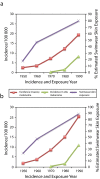More skin, more sun, more tan, more melanoma
- PMID: 25211764
- PMCID: PMC4202947
- DOI: 10.2105/AJPH.2014.302185
More skin, more sun, more tan, more melanoma
Abstract
Although personal melanoma risk factors are well established, the contribution of socioeconomic factors, including clothing styles, social norms, medical paradigms, perceptions of tanned skin, economic trends, and travel patterns, to melanoma incidence has not been fully explored. We analyzed artwork, advertisements, fashion trends, and data regarding leisure-time activities to estimate historical changes in UV skin exposure. We used data from national cancer registries to compare melanoma incidence rates with estimated skin exposure and found that they rose in parallel. Although firm conclusions about melanoma causation cannot be made in an analysis such as this, we provide a cross-disciplinary, historical framework in which to consider public health and educational measures that may ultimately help reverse melanoma incidence trends.
Figures

Similar articles
-
Knowledge about Ultraviolet Radiation Hazards and Tanning Behavior of Cosmetology and Medical Students.Acta Dermatovenerol Croat. 2016 Apr;24(1):73-7. Acta Dermatovenerol Croat. 2016. PMID: 27149135
-
Sun-related knowledge and attitudes of primary and secondary schoolchildren in western Switzerland.Eur J Cancer Prev. 2017 Sep;26(5):411-417. doi: 10.1097/CEJ.0000000000000279. Eur J Cancer Prev. 2017. PMID: 27749495
-
Tanning themselves to death: a new teen fad.Mo Med. 2012 May-Jun;109(3):166-70. Mo Med. 2012. PMID: 22860276 Free PMC article.
-
Tanning beds, skin cancer, and vitamin D: An examination of the scientific evidence and public health implications.Dermatol Ther. 2010 Jan-Feb;23(1):61-71. doi: 10.1111/j.1529-8019.2009.01291.x. Dermatol Ther. 2010. PMID: 20136909 Review.
-
Prevalence of sunburn, sun protection, and indoor tanning behaviors among Americans: review from national surveys and case studies of 3 states.J Am Acad Dermatol. 2011 Nov;65(5 Suppl 1):S114-23. doi: 10.1016/j.jaad.2011.05.033. J Am Acad Dermatol. 2011. PMID: 22018060 Review.
Cited by
-
Skin epidermal keratinocyte p53 induces food uptake upon UV exposure.Front Behav Neurosci. 2023 Dec 12;17:1281274. doi: 10.3389/fnbeh.2023.1281274. eCollection 2023. Front Behav Neurosci. 2023. PMID: 38152309 Free PMC article.
-
Implementation of the SunSmart program and population sun protection behaviour in Melbourne, Australia: Results from cross-sectional summer surveys from 1987 to 2017.PLoS Med. 2019 Oct 8;16(10):e1002932. doi: 10.1371/journal.pmed.1002932. eCollection 2019 Oct. PLoS Med. 2019. PMID: 31593565 Free PMC article.
-
Developing strategies to predict photodynamic therapy outcome: the role of melanoma microenvironment.Tumour Biol. 2015 Dec;36(12):9127-36. doi: 10.1007/s13277-015-4059-x. Epub 2015 Sep 29. Tumour Biol. 2015. PMID: 26419592 Review.
-
Research hotspots and trends of immunotherapy and melanoma: A bibliometric analysis during 2014-2024.Hum Vaccin Immunother. 2025 Dec;21(1):2464379. doi: 10.1080/21645515.2025.2464379. Epub 2025 Feb 26. Hum Vaccin Immunother. 2025. PMID: 40012099 Free PMC article.
-
The Dislike of Hot Thermal Conditions and Its Relationship with Sun (Ultraviolet Radiation) Exposure in the Southeastern United States.Int J Environ Res Public Health. 2018 Oct 1;15(10):2161. doi: 10.3390/ijerph15102161. Int J Environ Res Public Health. 2018. PMID: 30275387 Free PMC article.
References
-
- Jemal A, Devesa SS, Hartge P, Tucker MA. Recent trends in cutaneous melanoma incidence among whites in the United States. J Natl Cancer Inst. 2001;93(9):678–683. - PubMed
-
- Flórez Á, Cruces M. Melanoma epidemic: true or false? Int J Dermatol. 2004;43(6):405–407. - PubMed
-
- Elwood JM, Jopson J. Melanoma and sun exposure: an overview of published studies. Int J Cancer. 1997;73(2):198–203. - PubMed
-
- Ting W, Schultz K, Cac NN, Peterson M, Walling HW. Tanning bed exposure increases the risk of malignant melanoma. Int J Dermatol. 2007;46(12):1253–1257. - PubMed
Publication types
MeSH terms
Grants and funding
LinkOut - more resources
Full Text Sources
Other Literature Sources
Medical

